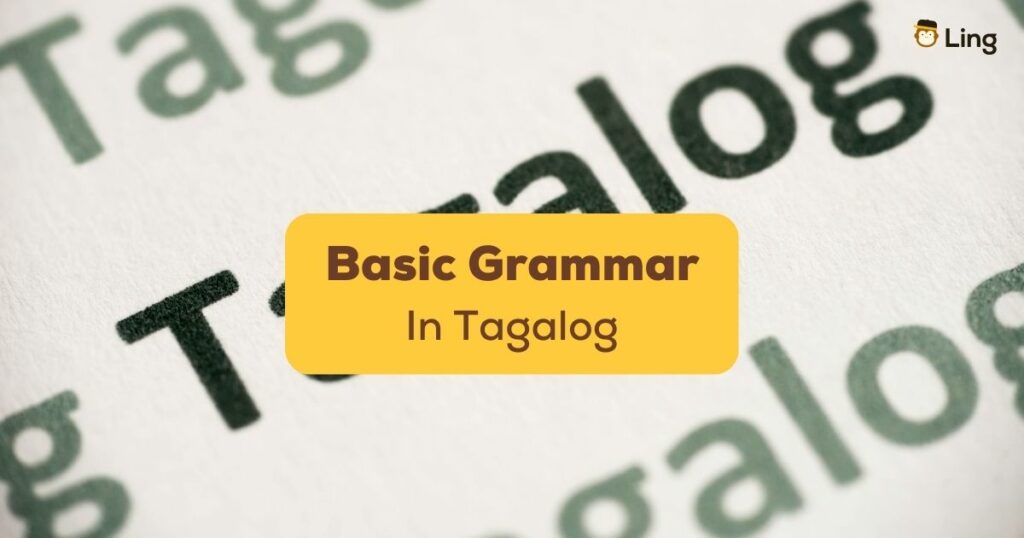Have you ever wanted to learn Tagalog but need help knowing where to start? Well, you’re in luck because this article is the best guide to basic Tagalog grammar.
Don’t worry. We won’t bore you with complex grammar rules! Everything you need to know to get started with Tagalog is right here. By the time you’re done, you’ll be speaking Tagalog like a pro! So, let’s learn Tagalog, and have some fun while we’re at it!
Table of Contents
What Are Tagalog Nouns And Pronouns?
Are you ready to start your Filipino grammar journey? Let’s get started with the basics of Tagalog nouns! Don’t be intimidated. This will be a breeze!
Nouns are the building blocks of language, so it’s essential to grasp them well. In Tagalog, nouns are like the main characters of sentences – they’re the words that represent people, places, things, and ideas.
One cool thing about the Tagalog language is that it’s a gender-neutral language. So, you won’t find Tagalog pronoun equivalents for “he” or “she.” Instead, the Tagalog word “siya” refers to both male and female subjects.
For example:
- English: He/She took the book yesterday.
- Tagalog: Siya ang kumuha ng libro kahapon.
Here’s a table to help you understand Tagalog gender-neutral pronouns:
| English | Tagalog |
|---|---|
| He/She | Siya |
| His/Her | Kanyang |
| Himself/Herself | Sarili |
Plural Forms
When it comes to making nouns plural, things are a bit different from English. Instead of adding an “s” at the end of the word, we use the marker “mga” or “sina” before the noun. “Sina” is used for plural personal names, while “ang mga” is for all other plural forms of nouns. These markers are like the key to unlocking the world of plural nouns in Tagalog.
For example:
| English | Tagalog |
|---|---|
| Alfred and company | Sina Alfred |
| Dogs | Mga Aso |
| Cats | Mga Pusa |
| Horses | Mga Kabayo |
| Animals | Mga Hayop |
Noun Markers
In Tagalog, Tagalog noun markers are words that help us identify and specify nouns in a sentence. They add meaning and provide context to the nouns they modify. Let’s dive into the world of noun markers, or as I like to call them, “Tagalog superheroes”!
Si
First up, we have our trusty sidekick, “si.” This little marker is used for personal names. So, when you want to mention someone’s name, just put “si” in front of it. For example, “si Alfred” means “Alfred.”
Ang
Next, we have the superstar “ang.” This marker is for all other nouns that are not personal names. It’s like the “the” in English. So, when you want to say “the woman,” you can simply say “ang babae.”

What Are Tagalog Verbs And Verb Tenses?
Verbs may be one of the trickiest aspects of basic Tagalog grammar, especially for those who are not well-versed in the language. However, with a bit of effort, anyone can master verb tenses, which work pretty much the same way as in English.
Verb Groups
Basically, Tagalog verbs consist of a root word and an affix. To change the tense or meaning of the verb, an affix should be added to the beginning, middle, or end of the verb root. In some cases, the first syllable of the word is repeated. To make things easier, Tagalog verbs are grouped according to how they are conjugated. They can either be mag-, ma-, -um, -in, or -i verbs.
Below are examples of how words are conjugated in each group:
| Verb Group | Root Verb | Future Tense | Present Tense | Past Tense | Imperative |
|---|---|---|---|---|---|
| Mag- | Lakad (walk) | Maglalakad (will walk) | Naglalakad (walking) | Naglakad (walked) | Maglakad (to walk) |
| Ma- | Tulog (sleep) | Matutulog (will sleep) | Natutulog (sleeping) | Natulog (slept) | Matulog (go to sleep) |
| -Um | Takbo (run) | Tatakbo (will run) | Tumatakbo (running) | Tumakbo (ran) | Tumakbo (to run) |
| -In | Kain (eat) | Kakainin (will eat) | Kinakain (eating) | Kinain (ate) | Kainin (to eat) |
| -I | Sulat (write) | Isusulat (will write) | Isinusulat (writing) | Isinulat (wrote) | Isulat (to write) |
Verb Repetition
Aside from learning how to conjugate verbs, it is also essential to know how to repeat verbs when expressing a prolonged action. This is a unique characteristic of Tagalog grammar. When two verbs are repeated this way, they are connected by the word “nang.”
For example:
- English: Anna keeps on crying.
- Tagalog: Iyak nang iyak si Anna.

What Are Tagalog Adjectives?
Adjectives are like paintbrushes that help us paint vivid pictures with words. They describe nouns and give them life. Want to talk about a beautiful sunset or a delicious meal? You’re going to need some adjectives!
Adjective-Noun Identicals
Some Tagalog adjectives are identical to nouns in both spelling and meaning, but their pronunciation may differ. Just imagine adding a long vowel sound to the noun, and voilà! You have the corresponding adjective.
For example:
- Adjective: buhay – alive
- Noun: buhay – life
Adjective Gender
In Tagalog, there are adjectives specifically used to describe female individuals. These words usually end in /a/. So, when you want to compliment a woman, you can use these adjectives to make her feel extra special.
For example, the word nervous would be:
- Male – nerbyoso
- Female – nerbyosa
Degrees Of Adjectives
Adjectives in Tagalog can have different degrees to show intensity. Let’s explore two of these degrees: the intensive and superlative degrees.
In the intensive degree, you can emphasize the level of quality by using the preceding word, “napaká.” This will intensify the meaning of the adjective. Also, be mindful of the word order. Napaká should always come before the adjective.
For example:
- Very beautiful – Napakagandá
In the superlative degree, you can use the word “pinaká” before the adjective to express that something is the most or the best.
For example:
- The most beautiful – Pinakamagandá
To add even more emphasis, you can simply repeat the adjective or use variations of it. This adds a playful touch to your sentence.
For example:
- Extremely beautiful – Magandáng-magandá
How Do You Say Basic Tagalog Grammar In Tagalog?
The Tagalog phrase for Basic Tagalog Grammar is Pangunahing Balarilang Grammatika.
How do you say “I want to learn basic Tagalog grammar” in Tagalog? You can say it like, “Gusto ko magaral ng pangunahing Balarilang Grammatika.”
If you want to ask someone else to teach you Tagalog grammar, you can ask this question word:
Pwede mo ba akong turuan ng Pangunahing Balarilang Grammatika?
In English, this Tagalog phrase means, “Can you teach me basic Tagalog Grammar?”
Other Vocabulary About Basic Tagalog Grammar
After seeing the basic Tagalog grammar explanations above, we have additional vocabulary that you can practice with.
Take a look at some of these Tagalog sentences with basic Tagalog grammar and try memorizing them:
Want to learn more vocabulary, words, and phrases? Download the Ling app on the App Store or Play Store today!
Frequently Asked Questions About Basic Tagalog Grammar
What Is The Grammatical Structure In A Tagalog Sentence?
The grammatical structure in a Tagalog sentence is often in VSO (Verb-Subject-Object). This is also called the Tagalog sentence structure or word order. However, you can still use the SVO (Subject-Verb-Object) word order when constructing a Tagalog conversation or sentence. But, this may sound too formal or outdated for many native Tagalog speakers.
When Do You Use Ng And Nang In a Tagalog Sentence?
Ng is a Tagalog conjunction that is used by a verb to conjunct an object. It can also be a Tagalog preposition equivalent to the English word of and for. On the other hand, nang is used for Tagalog adverbs or adverbial phrases. It is also connected to Tagalog words that you repeat for emphasis.
For example:
These two words are one of the common mistakes that even Filipinos make when constructing written Tagalog sentences. But, after enough practice of basic Tagalog grammar, these sentences will make you sound like a natural!
How Difficult Is Tagalog Grammar?
Tagalog grammar is neither easy nor hard. It all depends on your learning routine and discipline. If you practice everyday along with more examples from audio to context-based activities, then you’ll get used to the Tagalog language.
English native speakers will tend to have a hard time pronouncing the Tagalog words because its language family is nearer to Austronesian (Malayo-Polynesian) language family.
Another reason why people think Tagalog is hard to learn is because of the lack of resources and demand for this beautiful language.
But, we’ve got the best app to help you learn it easily! Need to be convinced more? We got you!

Unlock The Secrets Of Basic Tagalog Grammar With Ease!
Hey there, language enthusiasts! We hope you found our guide to basic Tagalog grammar super helpful. With these grammar rules under your belt, you’ll have the power to express yourself and connect with native speakers on a whole new level. Whether you’re planning a trip to the Philippines or simply want to impress your Filipino friends, mastering the basics is the first step to this beautiful language.
Remember, learning a language is an adventure, so don’t be afraid to make mistakes and keep practicing. The more you engage with Tagalog grammar, the more confident and fluent you’ll become.
Learn Tagalog With Ling
Are you tired of traditional language learning methods that make you yawn and lose motivation? Say hello to the Ling app – the revolutionary language learning app that will make mastering languages an exciting adventure!
With Ling App, language learning is no longer a tedious chore but a fun-filled journey of discovery. Our user-friendly interface and interactive features make learning languages addictive, keeping you engaged and eager to learn more. Whether you’re a beginner or an advanced learner, Ling app provides personalized lessons tailored to your proficiency level, so you can progress at your own pace and feel confident in your abilities. Learning a new language has never been this captivating!


































































